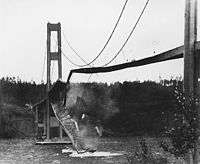Division Street Bridge (Spokane)
| Division Street Bridge | |
|---|---|
 View of the collapse, taken from the south bank of the Spokane River looking northward | |
| Crosses | Spokane River |
| Locale | Spokane, Washington |
| Named for | Division Street |
| Characteristics | |
| Trough construction | Concrete |
| Total length | 600ft |
| History | |
| Designer | Hugh L. Cooper |
| Opened | 1882 |
| Rebuilt | 1992 |
The Division Street Bridge in Spokane, Washington, is a 600-foot concrete span that crosses the Spokane River just north of Spokane's downtown area and a half-mile east (upstream) of Spokane Falls. Approximately 270 feet of the span is over water. The bridge was rebuilt in 1992 to increase its capacity.
The original bridge was a wooden truss structure built in 1882, which was replaced in 1892 by the steel bridge. The designer, Hugh L. Cooper from New York, designed the bridge to hold a dead load of 4800 pounds per linear foot, which he claimed was a weight far greater than any standard freight train at the time. The bridge was designed with two streetcar tracks, roadbed for horse and wagon (and, later, automobile) traffic, and pedestrian sidewalks.
1915 collapse
During a flood in 1894, a railroad bridge upstream from downtown Spokane was washed out and collided with the steel span at Division Street. The beams that would later break in 1915 bore signs of significant damage and were repaired by re-welding.
At 6:11 am on Saturday, December 18, 1915, two Washington Water Power trolley cars were crossing the steel bridge, one headed north and the other south, when the repaired beams gave way. The northbound streetcar had nearly reached the far side and its snow scrapers snagged on debris on the north side, preventing it from rolling back into the river. All four occupants escaped without major injury. Because of the early hour and freezing weather, there were no pedestrians or automobiles crossing the bridge at the time.
The southbound streetcar, heading for downtown with 15 to 17 passengers, was close to the middle of the span when it fell. The Spokane River is around 30 to 40 feet deep at that point, but the fallen bridge deck had lodged onto old pilings below the surface and thus kept the car from being completely submerged in the freezing water.
All the fatalities and injuries came from the southbound car. A steel girder had sliced through the top half of the car, killing several people outright, and then pinned several more people in the water underneath it. The other victims avoided drowning by clinging to the wreckage, although the entire affair quickly became coated with ice.
The Spokane Fire Department responded to the scene but was coming from the south end of Division Street and was unable to reach the survivors from that point. After a 30-minute detour across another bridge, the Fire Department was able to lower ladders into the water on the north side to rescue the survivors and recover the remains of the deceased.
The bridge designer, Hugh L. Cooper, happened to be in Spokane working on another project at the time of the collapse. After inspecting the bridge, he felt that the damage suffered from the 1894 collision was largely responsible for the failure of the structural members. Another engineer also examined the disaster and questioned the quality of the steel that was used in its construction.[1]
The replacement span was a three-vault concrete bridge and served satisfactorily until 1992.
References
- ↑ Laura Arksey (February 14, 2006), Spokane's Division Street Bridge collapses on December 18, 1915, HistoryLink
External links
- "SEVEN KILLED AND TEN INJURED HEN DIVISION STREET, SPOKANE, STRUCTURE COLLAPSES AND PEOPLE FALL INTO RIVER". Ogden Standard. Ogden, Utah. December 18, 1915.
